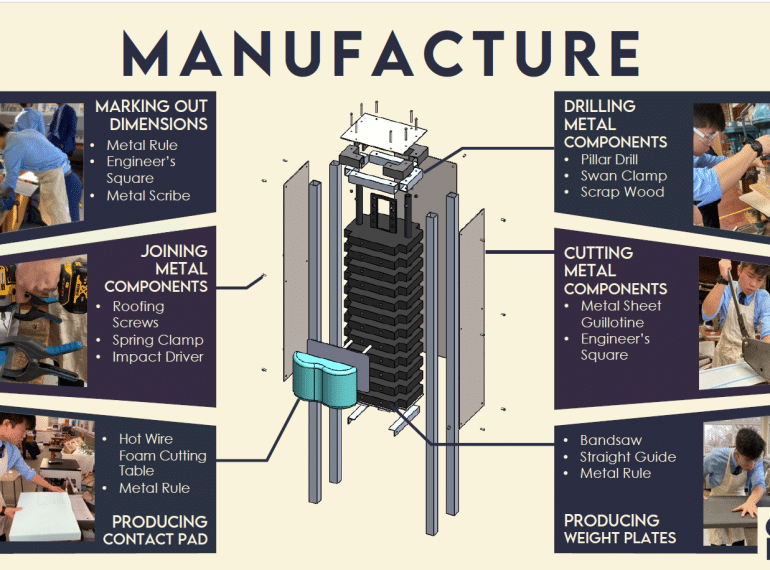
Two sixth-formers have been named as Arkwright Scholars after successfully demonstrating their prowess as engineers.
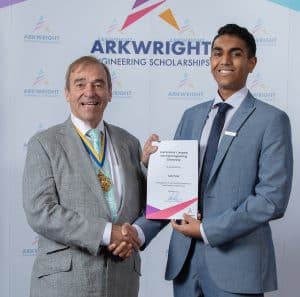 Darren Lee and Yash Patel laboured for months through a gruelling selection process for the scholarships, which will now provide them with financial and mentoring support during their A-level studies.
Darren Lee and Yash Patel laboured for months through a gruelling selection process for the scholarships, which will now provide them with financial and mentoring support during their A-level studies.
Head of Technology Michael Noonan said: “My congratulations go to both Yash and Darren: these scholarships are not lightly awarded, and the pair’s success is a reflection of their assiduous approach to the process, of their presentation skills, and, of course, of the excellent standard of their engineering.”
The long-running Arkwright programme is run by the national Science, Technology, Engineering & Mathematics (STEM) education charity, The Smallpeice Trust, and aims to inspire future leaders in engineering. This year, only 300 candidates were successful out of 1,423 applicants.
The benefits of the scholarships include a £600 personal financial award, £400 for the scholar’s school, mentoring, industry-based ‘Connect Days’ and invitations to university-based VIP receptions.
Darren and Yash, both of Year 12, were presented with certificates at an awards ceremony held at the Institution of Engineering and Technology in London.
As part of his application, Darren gave a presentation which covered the design and manufacture of ‘Overlap’ – a rugby lineout machine that he devised (pictured top). He also featured in his presentation his involvement with VEX Robotics at the School.
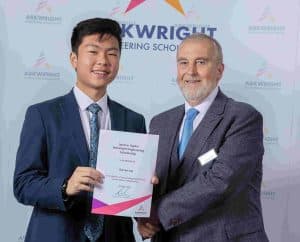 The process included an engineering aptitude test and an online interview, during which candidates had both to make a presentation and to respond to technical engineering questions.
The process included an engineering aptitude test and an online interview, during which candidates had both to make a presentation and to respond to technical engineering questions.
He said: “It’s an absolute honour to receive this scholarship, recognising my engineering skills and hours of hard work I’ve put into my technology projects. I’m incredibly proud to call myself an Arkwright Scholar.
“I believe that the networking aspect of this scholarship will prove to be very beneficial. As an Arkwright Scholar, I have access to the MentorNet platform, where I can communicate, discuss and receive feedback from some of the brightest young engineering minds in the country.”
For his part, Yash says that being an Arkwright Scholar will assist him in pursuing interests such as model-making, CAD design and 3D printing out of School and will help him fund a wishlist of projects, including making movie props and designing his own model train set and an electric guitar.
“It means I will be provided with opportunities, such as work experience, Connect Days and bursary offers or further scholarships, which may not be provided to others, as I will stand out to engineering-related organisations,” said Yash. “I have become a more competitive university applicant and can build up a larger network of prominent engineers and leaders in the industry.”
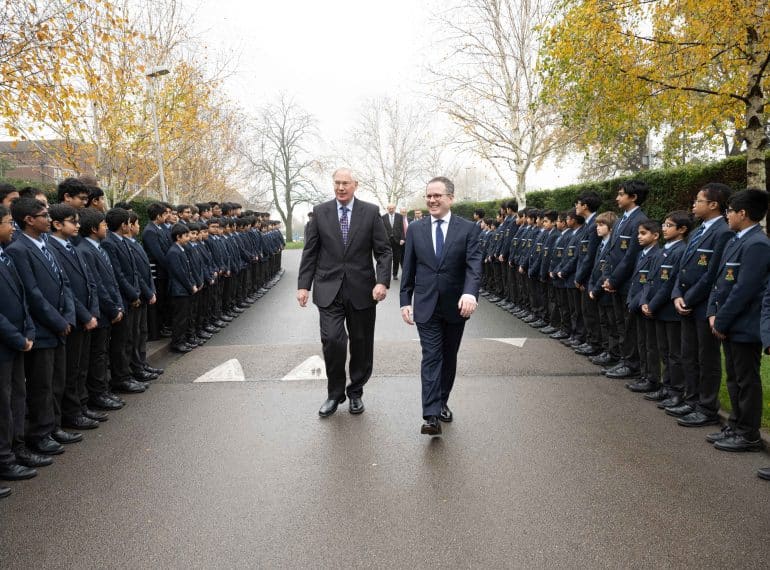
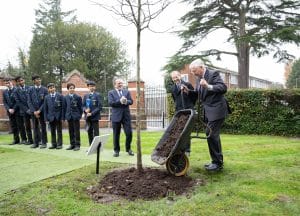 Members of the School’s Combined Cadet Force flanked the main entrance and the senior rugby team provided a sporting backdrop as the Duke arrived for his visit, during which he marked the anniversary by planting an oak tree and by presenting a specially embroidered banner to Headmaster Neil Enright.
Members of the School’s Combined Cadet Force flanked the main entrance and the senior rugby team provided a sporting backdrop as the Duke arrived for his visit, during which he marked the anniversary by planting an oak tree and by presenting a specially embroidered banner to Headmaster Neil Enright.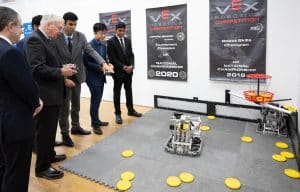 Following the visit, Mr Enright said: “It was a tremendous honour and my great pleasure to welcome HRH The Duke of Gloucester today. With the anniversary fast approaching, there was much to show him, including the School’s original 1573 Charter signed by Elizabeth I, our Ties through Time installation of 232 School photographs from the 1880s until comparatively modern times, and, to bring things right up to date, the robots and our new Music building, opened in May.
Following the visit, Mr Enright said: “It was a tremendous honour and my great pleasure to welcome HRH The Duke of Gloucester today. With the anniversary fast approaching, there was much to show him, including the School’s original 1573 Charter signed by Elizabeth I, our Ties through Time installation of 232 School photographs from the 1880s until comparatively modern times, and, to bring things right up to date, the robots and our new Music building, opened in May.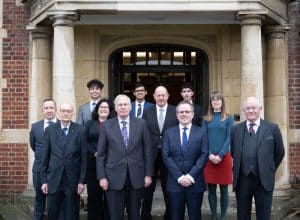 He was then introduced to:
He was then introduced to: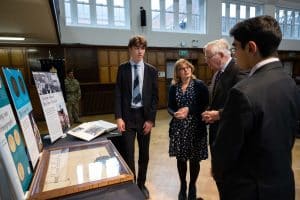 Gabriel Gulliford.
Gabriel Gulliford.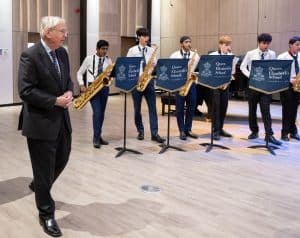 After visiting the Ties through Time photographic installation and enjoying the robotics in the School’s Conference Centre, the royal party headed to the new Music building to watch rehearsals for this Thursday’s Winter Concert under the watchful eye of Director of Music Ruth Partington.
After visiting the Ties through Time photographic installation and enjoying the robotics in the School’s Conference Centre, the royal party headed to the new Music building to watch rehearsals for this Thursday’s Winter Concert under the watchful eye of Director of Music Ruth Partington.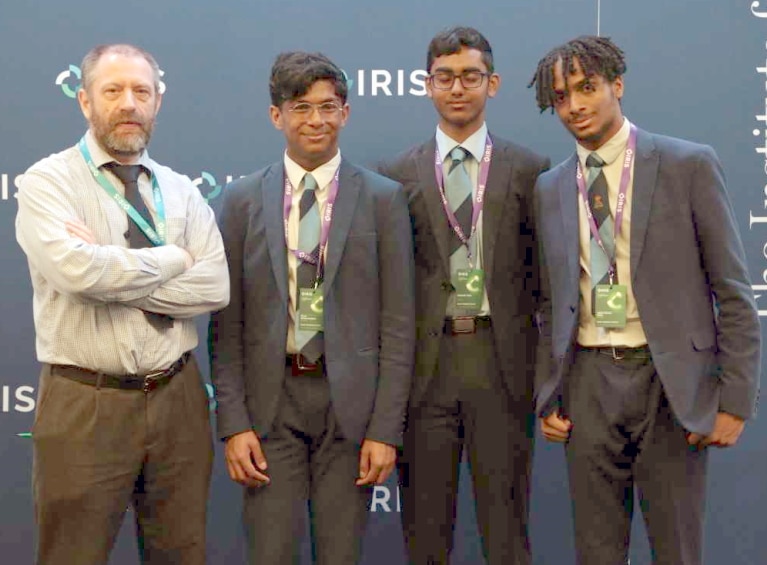
 Mr Brooke, who accompanied them to the conference, said: “Every step of the process was driven by the initiative of the boys, and it was fitting that one of the guests on the Scientist Panel that concluded the event, Dr Harshnira Patani, Senior Scientist Pharmacology at MSD (one of the world’s leading pharmaceutical companies), singled out the boys’ presentation as her highlight of the conference, making particular note of their use of machine learning.”
Mr Brooke, who accompanied them to the conference, said: “Every step of the process was driven by the initiative of the boys, and it was fitting that one of the guests on the Scientist Panel that concluded the event, Dr Harshnira Patani, Senior Scientist Pharmacology at MSD (one of the world’s leading pharmaceutical companies), singled out the boys’ presentation as her highlight of the conference, making particular note of their use of machine learning.”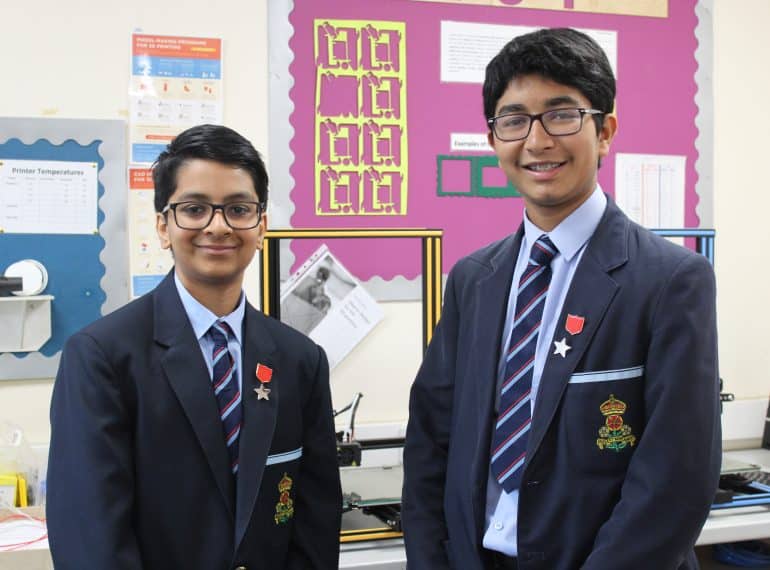
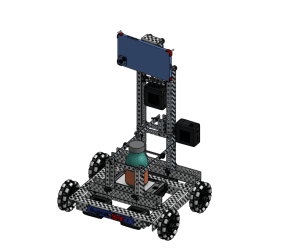 Their Buginator robot is designed to help farmers combat swarms of pests, thus protecting precious ecosystems while the farmers remain safely inside.
Their Buginator robot is designed to help farmers combat swarms of pests, thus protecting precious ecosystems while the farmers remain safely inside.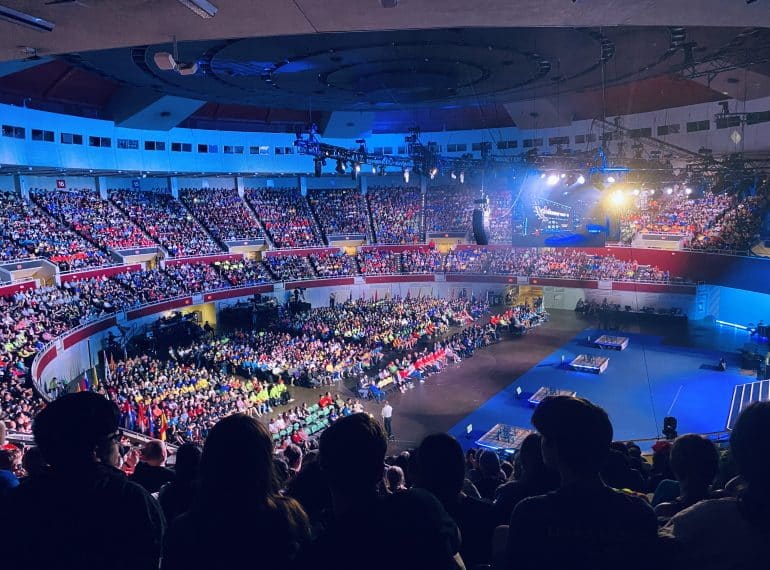
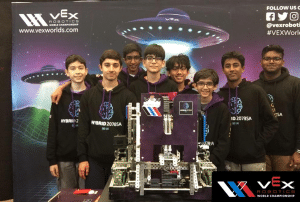 “The final stages of the match were met with rapturous applause from UK supporters…and Hybrid were suddenly the great hope of UK teams and mentors,” Mr Noonan said. “With this, confidence levels in the team grew, and they swatted the semi-final challenge of a once-again higher-ranked alliance with ease, with a score of 163-76.” Their “fairy-tale journey” then came to an end as they lost out to a very high-scoring alliance.
“The final stages of the match were met with rapturous applause from UK supporters…and Hybrid were suddenly the great hope of UK teams and mentors,” Mr Noonan said. “With this, confidence levels in the team grew, and they swatted the semi-final challenge of a once-again higher-ranked alliance with ease, with a score of 163-76.” Their “fairy-tale journey” then came to an end as they lost out to a very high-scoring alliance.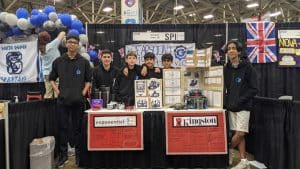 “All teams put in an incredible effort, but none managed to secure that coveted prize of a place in the world finals,” said Mr Noonan. Nevertheless, Gearsquad won an Inspire Award and a top-50 place for Skills, while Nova, Cyberforce, Rubber Bands and Eclipse all secured online challenge awards.
“All teams put in an incredible effort, but none managed to secure that coveted prize of a place in the world finals,” said Mr Noonan. Nevertheless, Gearsquad won an Inspire Award and a top-50 place for Skills, while Nova, Cyberforce, Rubber Bands and Eclipse all secured online challenge awards.
 Lending their expertise and experience on the day were four 2017 leavers: Aadil Kara, Neelesh Ravichandran and Harikesan Baskaran and Suchira Peiris. Aadil, Neelesh and Harikesan all got through to the national stages of the UK Space Design Competition (Galactic Challenge’s ‘big brother’ for older pupils) when they were in Year 13, with Aadil going on to reach international level.
Lending their expertise and experience on the day were four 2017 leavers: Aadil Kara, Neelesh Ravichandran and Harikesan Baskaran and Suchira Peiris. Aadil, Neelesh and Harikesan all got through to the national stages of the UK Space Design Competition (Galactic Challenge’s ‘big brother’ for older pupils) when they were in Year 13, with Aadil going on to reach international level. The challenge has two main objectives: to help foster pupils’ interest in Science, Technology, Engineering and Mathematics (STEM), and to help them develop so-called ‘soft skills’, such as team-working, communication, and the ability to solve complex problems.
The challenge has two main objectives: to help foster pupils’ interest in Science, Technology, Engineering and Mathematics (STEM), and to help them develop so-called ‘soft skills’, such as team-working, communication, and the ability to solve complex problems. Suchira left QE to read Politics and International Studies at the University of Warwick, before securing a role as a consulting data analyst at the Information Lab. He said: “As a volunteer it was inspiring to see how engaged and active the students were in the competition, the out-of-the-box thinking, novel problem-solving and, in nearly every case, a board-worthy presentation!”
Suchira left QE to read Politics and International Studies at the University of Warwick, before securing a role as a consulting data analyst at the Information Lab. He said: “As a volunteer it was inspiring to see how engaged and active the students were in the competition, the out-of-the-box thinking, novel problem-solving and, in nearly every case, a board-worthy presentation!” After trailing team Astrodyne Delta through the early stages of the competition, Solaris Flight Systems came through in the final stage to secure victory by the tightest of margins, winning contracts worth £320bn, against Astrodyne Delta’s £315bn. Infinity Airspace were not too far behind, on £300bn, with all three impressing the judges and securing contracts.
After trailing team Astrodyne Delta through the early stages of the competition, Solaris Flight Systems came through in the final stage to secure victory by the tightest of margins, winning contracts worth £320bn, against Astrodyne Delta’s £315bn. Infinity Airspace were not too far behind, on £300bn, with all three impressing the judges and securing contracts.